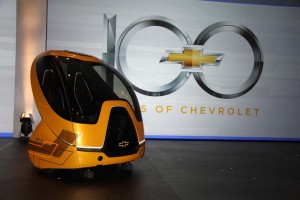It looks like a self-propelled rickshaw, with more in common with the quirky Segway personal mobility device than a conventional automobile, but General Motors is convinced its EN-V concept vehicle could play a major role in the future of transportation.
So, the U.S. maker says it will develop a second-generation EN-V to not only test out the idea of operating on only two wheels but also to explore concepts that include autonomous mobility – the sci-fi fantasy of cars that can operate entirely on their own.
“We someday anticipate connecting all vehicles through a mobility network that could include autonomous driving,” said Jim Federico, a senior product executive with GM, which showed off a prototype of the EN-V gen-two during a news conference celebrating the 100th anniversary of the Chevrolet brand.
The original concept, first shown at the 2009 New York Auto Show, carried a generic GM badge. The switch to Chevrolet reflects that brand’s role as the primary provider of basic transportation within the General Motors family, explained Chip Perry, GM’s vice president of global marketing.
“By 2030, more than 60% of the world’s 8 billion people will live in urban areas,” he noted. “The Chevrolet EN-V represents a possible solution for global customers living in markets where alternative transportations solutions are needed.”
Short for Electric Networked-Vehicle, the EN-V evolved out of the Puma concept that GM developed with Segway which markets a scooter-like contraption – and which appeared in 2010 at the Shanghai World Expo. Like the Segway, EN-V uses two parallel wheels, rather than having them in tandem, motorcycle-style. But the EN-V concept allows two to ride seated, side-by-side.
The latest design is highlighted by LED accent lighting, including lamps that frame each of the two seats.
But the real advanced technology is largely hidden out of view. What GM is working on will allow passengers in the EN-V to stay connected to the world around them through advanced infotainment systems. The vehicle itself will also be connected to a special mobility network, GM planners suggest, which would allow for car-to-car communications, which might one vehicle to the presence of another at a blind intersection.
A series of vehicles might be able to platoon on a highway, driving mere inches off each other’s bumpers.
But it could also serve as the foundation for the eventual ability for autonomous driving. Slip inside, punch in a destination and lay back for an extra few minutes of sleep during the morning commute.
The second-generation EN-V will, as with the original, be battery-powered. That has a variety of advantages, especially if fuel prices keep rising. But it also could permit continued access to city centers as a number of large metropolitan areas are considering levying hefty access fees on — or even banning outright – gas-powered vehicles.
Earlier this year, GM signed a memorandum of understanding with the Sin-Singapore Tianjin Eco-City Investment and Development Co. to study ways to integrate a vehicle like EN-V into their planned environmentally-friendly community.
“This technology platform of electric propulsion, sensors, wireless communications and GPS-based navigation is likely to migrate from the EN-V concept to other automobiles and could lead the way to safer, cleaner vehicles in the future,” said Chris Borroni-Bird, director of GM’s Advanced Technology Vehicle Concepts.
GM isn’t the only maker looking at pod-like vehicle designs. Toyota, for one, has shown several concepts in recent years.
Could there be a real market? GM officials say the simple design could prove popular as an entry-level commuter car for urban residents in major cities around the world. The next-generation EN-V concept could provide a test bed to see if they’re right.

